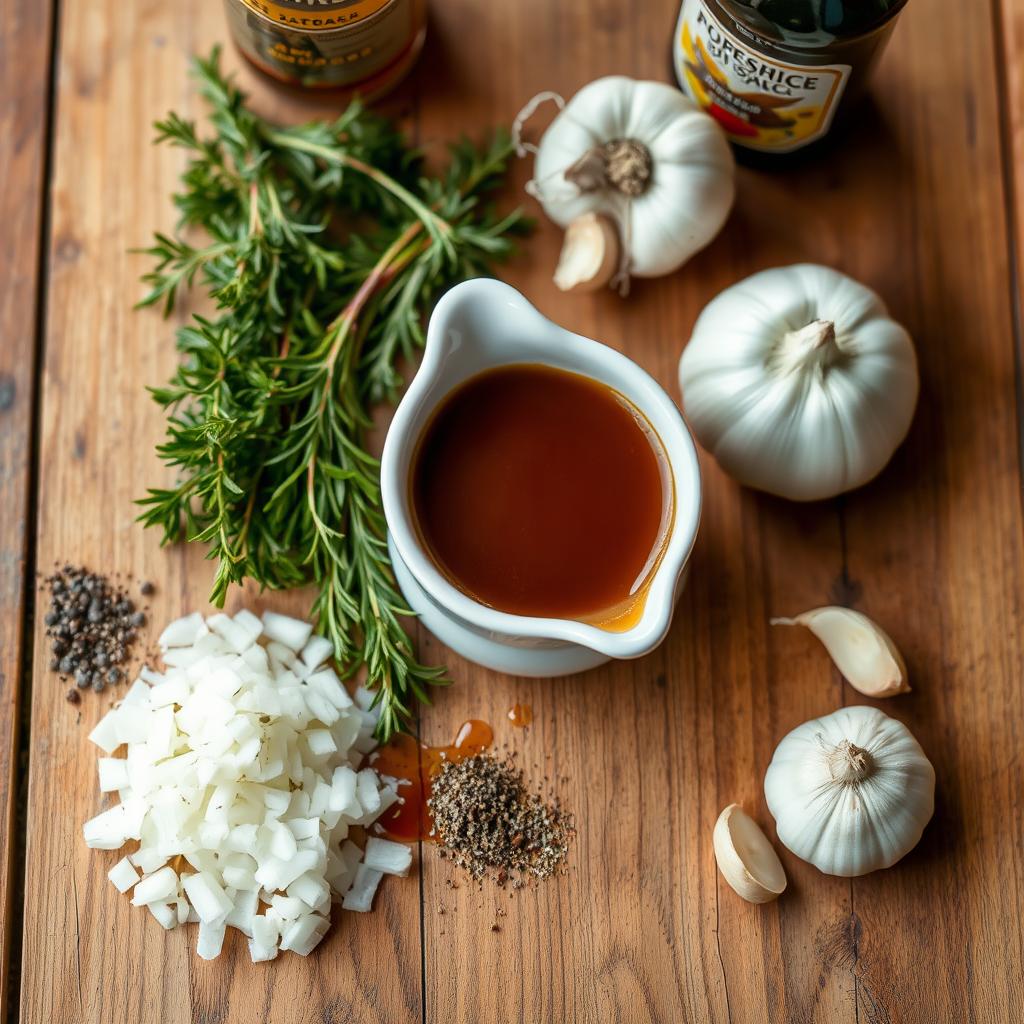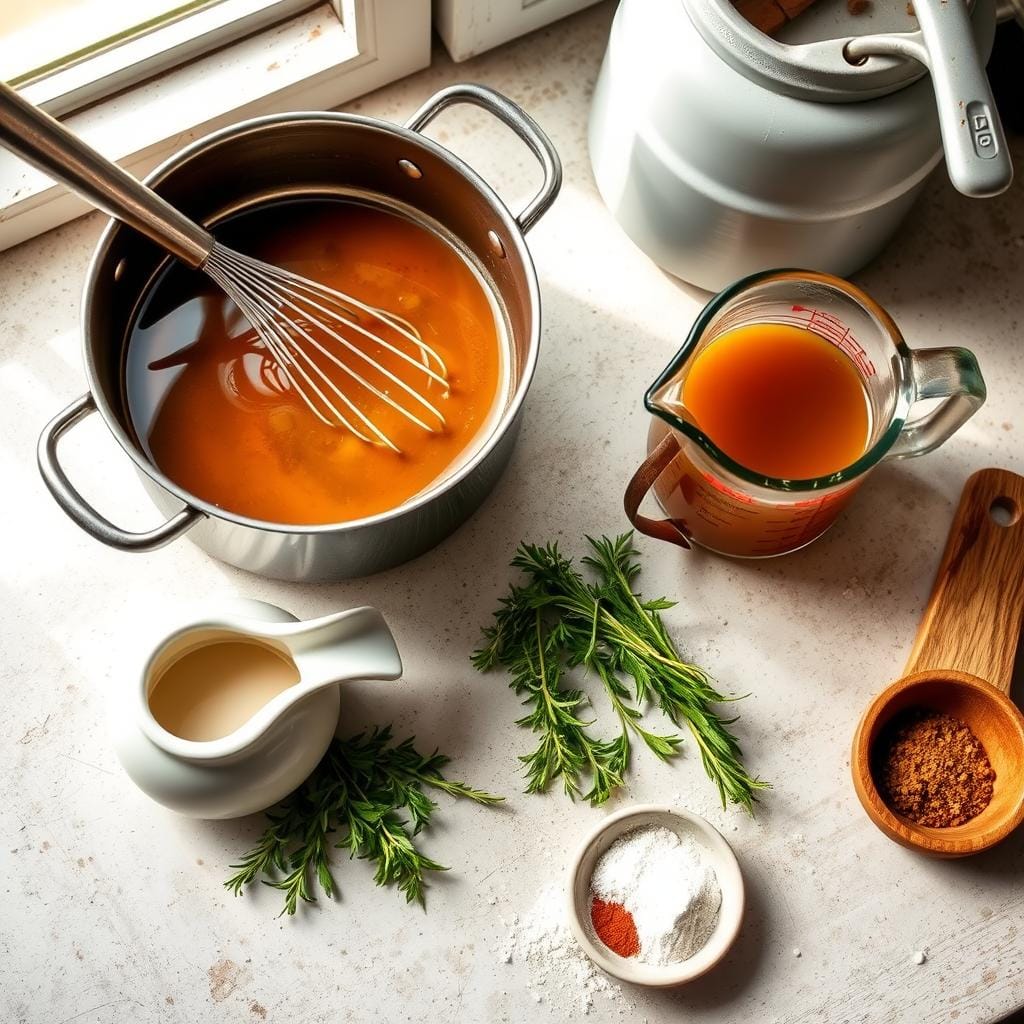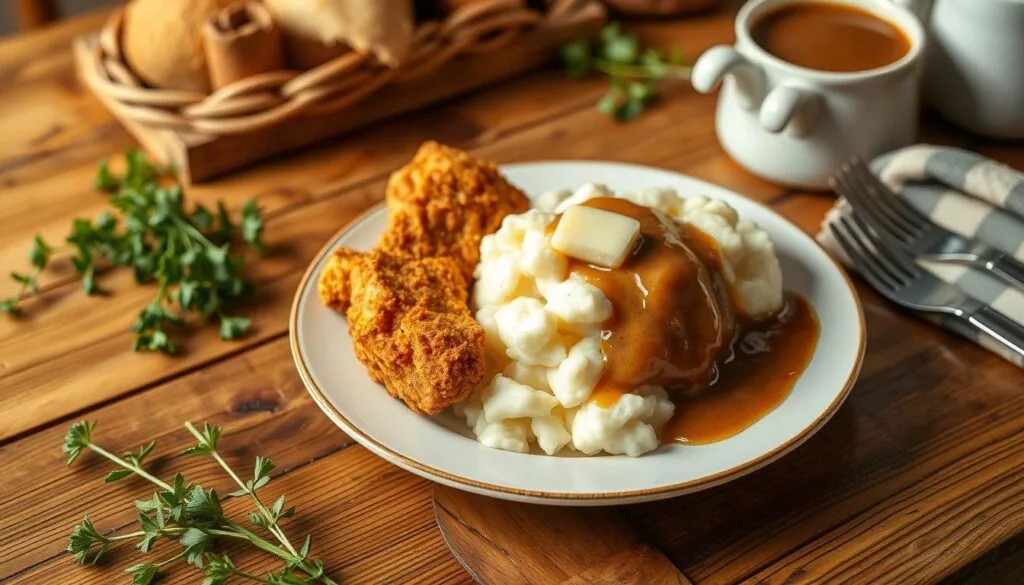What is the secret to good gravy? I’ve always loved cooking at home and dreamed of making a silky-smooth gravy. This simple sauce can elevate any dish into something special. My grandmother’s Thanksgiving gravy was legendary, always bringing our family together.
It had the perfect mix of flavor and texture. I’ve been trying to make something like it in my kitchen.
Have you struggled with making gravy? Maybe it’s been too lumpy or too bland. Don’t worry, I’ve got you covered. In this guide, I’ll share the secrets to making the ultimate gravy.

Key Takeaways
- Understand the essential elements of perfect gravy making
- Explore the role of roux and the importance of quality stock
- Discover the basic equipment needed for effortless gravy preparation
- Master the art of seasoning for maximum flavor
- Avoid common gravy-making mistakes and achieve the perfect consistency
The Essential Elements of Perfect Gravy Making
Making a delicious gravy needs a mix of key ingredients and techniques. At the core is knowing about the
role of roux
, the value of quality
stock
, and the must-have
equipment
for mastering gravy.
Understanding the Role of Roux
Roux is a mix of flour and fat, the base for a smooth gravy. The ratio and cooking time of the roux affect the gravy thickening techniques and gravy consistency. Cooking the roux right makes the flour’s starches swell, thickening the liquid and adding a rich, silky feel.
Importance of Quality Stock
The stock you pick for your gravy is key. A good, flavorful stock is the foundation of your gravy. Whether homemade or store-bought, the stock’s quality affects the dish’s depth and complexity.
Basic Equipment Needed
- Heavy-bottomed saucepan or skillet
- Whisk or wooden spoon
- Fine-mesh strainer
- Measuring cups and spoons
- Instant-read thermometer (optional)
With the right tools and knowledge of these key elements, you’ll make the perfect gravy every time.

What is the Secret to Good Gravy?
The secret to making great gravy is mixing the right ingredients. To get it just right, you need to focus on a few key things.
First, the quality of your stock or drippings matters a lot. Using flavorful, seasoned stock as a base gives your gravy a rich taste. Also, adding meat drippings can add a savory depth.
Getting the roux right is also key. The roux is what thickens your gravy. It’s all about finding the right mix of fat and flour and cooking it just right.
- Choosing the right seasonings, from herbs and spices to umami boosters, can make your gravy even better.
- Watching the temperature and stirring carefully helps make your gravy smooth and lump-free.
By mastering these basic gravy flavor enhancers, you’ll learn the secret to making a truly amazing what is the secret to good gravy?
“The key to good gravy is in the details – the quality of your stock, the technique of your roux, and the balance of your seasonings. Get those elements right, and you’ll have a gravy that will have your guests asking for seconds.”

| Ingredient | Purpose |
|---|---|
| Meat Drippings | Adds richness and depth of flavor |
| Roux | Thickens and binds the gravy |
| Herbs and Spices | Enhances the overall flavor profile |
| Umami Boosters | Heightens the savory notes |
Mastering the Base: Stock and Drippings
Making a flavorful gravy begins with a strong base. The key to rich flavor is in the meat drippings and homemade stock. While store-bought options are available, knowing how to make your own ingredients makes a big difference.
Collecting and Preparing Meat Drippings
The drippings from roasted or seared meats are full of flavor. Make sure to collect them carefully, avoiding any burnt bits. Strain these drippings through a fine-mesh sieve to get rid of any impurities. This will give you a great start for your gravy.
Making Homemade Stock
Homemade stock is crucial for a top-notch gravy. Whether you choose beef or chicken stock, the effort you put in will show. Simmer bones, veggies, and herbs to get all the flavor out. Then, strain and chill it for later use.
Store-bought Alternatives
When you’re short on time, good-quality store-bought broths and stocks can help. Choose ones with low sodium and no artificial preservatives. This way, you can still control the taste of your gravy.
“The secret to a truly remarkable gravy lies in the quality and preparation of its foundation – the stock and drippings.”
Choosing the Right Thickening Agent
Choosing the right thickening agent is key to perfecting your gravy. From classic roux to modern options, each thickener has its own benefits. Knowing these can take your gravy-making to the next level.
All-purpose flour is a common choice for thickening. Making a roux by cooking flour in fat gives your gravy a smooth texture. But, if you need something gluten-free, cornstarch or arrowroot powder work great. They give your gravy a clear, shiny look.
- Flour: Creates a rich, creamy texture, but can have a slightly floury taste if not cooked properly.
- Cornstarch: Produces a translucent, glossy gravy with a lighter mouthfeel.
- Arrowroot powder: Imparts a silky, lump-free consistency, making it suitable for delicate gravies.
The right thickener depends on the type of gravy you’re making. For thick meat gravies, flour-based roux is best. But for lighter sauces, like those for poultry or veggies, cornstarch or arrowroot is better. They let the natural flavors of your ingredients come through.
It doesn’t matter which thickener you choose. The secret to perfect gravy is in how much you use and when. Try different amounts and methods to find what works best for you. This way, you’ll always have the perfect gravy.
Proper Seasoning Techniques for Flavorful Gravy
Making a tasty gravy is more than just using the right ingredients. It’s about choosing the right seasonings and getting their balance right. Knowing how to season can make your gravy taste amazing.
Essential Herbs and Spices
To make a savory gravy, mix in some aromatic herbs and spices. Key players include:
- Fresh thyme: Adds a warm, earthy note
- Rosemary: Provides a slightly pine-like aroma and flavor
- Sage: Delivers a complex, slightly peppery taste
- Black pepper: Brings a subtle heat and vibrant kick
- Garlic powder: Lends a subtle, savory depth
- Onion powder: Enhances the overall richness
Balancing Salt and Pepper
Getting the right mix of salt and pepper is key for a tasty gravy. Start by tasting and adjust slowly. Remember, it’s easier to add more than it is to take it away. Aim for a mix that brings out the other flavors without being too strong.
Using Umami Enhancers
To add more depth to your gravy, use ingredients that boost umami. Good choices include:
- Soy sauce or Worcestershire sauce: Adds a deep, savory complexity
- Mushrooms or mushroom powder: Infuses an earthy, umami-packed punch
- Parmesan cheese: Provides a nutty, umami-forward flavor profile
With the right seasoning, your gravy can become a true masterpiece. It will impress your guests so much, they’ll want more.
Common Gravy Making Mistakes to Avoid
Making the perfect gravy can be tricky, even for experienced cooks. But don’t worry, we’ve got some key gravy troubleshooting and gravy making tips to help you avoid common mistakes. These tips will guide you to making a delicious gravy every time.
One common error is not thickening the gravy enough. If it’s too thin, add a bit more flour or cornstarch. But be careful not to add too much, or it will become too thick and sticky.
Another mistake is not seasoning the gravy well. Not enough salt, pepper, and spices can make it taste dull. Always taste and adjust the seasoning as you go, adding a little here and there until it’s just right.
| Common Gravy Mistakes | Solutions |
|---|---|
| Thin, watery gravy | Add more flour or cornstarch to thicken |
| Over-thickened, gloopy gravy | Thin out with more liquid (stock or milk) |
| Bland, under-seasoned gravy | Adjust salt, pepper, and other spices to taste |
| Lumpy or gritty texture | Strain the gravy through a fine-mesh sieve |
Finally, not straining the gravy can make it lumpy or gritty. Always strain it through a fine-mesh sieve to get a smooth, silky texture.
By following these gravy troubleshooting tips, you’ll be on your way to making perfect gravy every time. Happy cooking!
Achieving the Perfect Gravy Consistency
Making the perfect gravy is all about balance. With the right techniques, you can get it just right. From straining to controlling the temperature, these tips will help you achieve a smooth gravy every time.
Straining Methods
Straining is key to removing lumps and impurities. Use a fine-mesh sieve or cheesecloth to strain the gravy after it simmers. This will leave you with a silky-smooth consistency.
Temperature Control
- Maintain a gentle simmer: Avoid letting the gravy boil vigorously, as this can cause the starch to break down and result in a thin, watery consistency.
- Adjust heat as needed: If the gravy is too thick, simply add a bit of hot stock or water to thin it out. Conversely, if it’s too thin, let it simmer gently to allow the liquid to reduce and the gravy to thicken.
- Monitor the temperature: Use a thermometer to ensure the gravy stays within the ideal temperature range, typically between 185°F and 200°F.
By following these gravy making tips, you’ll be well on your way to achieving the perfect gravy consistency every time you make this beloved sauce.
| Straining Method | Benefit |
|---|---|
| Fine-mesh sieve | Removes small particles for a smooth texture |
| Cheesecloth | Captures even the finest of solids for a velvety finish |
Special Dietary Considerations for Gravy
Gravy recipes need to fit many diets. This includes gluten-free, vegetarian, and low-sodium options. This way, everyone can enjoy homemade gravy’s rich flavor.
Gluten-Free Gravy
Gluten-free folks can’t use wheat flour in gravy. Instead, use cornstarch, arrowroot powder, or blended cooked veggies. These thickeners make a smooth gravy without gluten.
Vegetarian and Vegan Gravies
- Use vegetable stock or broth for meat-free gravies.
- Blend sautéed mushrooms, onions, and herbs for a savory base.
- Add nutritional yeast for a cheesy flavor.
Low-Sodium Gravy Options
For low-sodium diets, skip bouillon cubes or powders. Use homemade stock instead. Also, watch the salt in your seasonings to keep it low.
With creativity and the right ingredients, you can make tasty gravies for all. Try these tips to make your gravy recipes inclusive and enjoyable for everyone.
Make-Ahead and Storage Tips
Preparing gravy ahead of time can save you a lot of stress. It’s perfect for busy holiday meals. Knowing how to store and reheat it right keeps the flavor and texture just right.
Freezing Guidelines
Gravy can stay frozen for up to 3 months. It’s a great choice for making ahead. Let it cool down, then put it in an airtight container or freezer-safe bag. To use, thaw it in the fridge overnight before heating it up.
Reheating Methods
Reheating frozen gravy is easy. The best way is to heat it gently on the stovetop over medium heat. Stir it now and then until it’s hot and smooth. You can also thaw it in the microwave, but stir it often to avoid burning.
Success in making gravy comes from the little details. Mastering make-ahead and storage tips means you can enjoy homemade gravy anytime. It’s hassle-free.
Regional Gravy Variations and Styles
Across the United States, you’ll find many different gravy styles. Each one shows off the local flavors and traditions of its area. From the South’s thick sausage gravies to the Midwest’s peppery beef gravies, these gravies highlight the sauce’s versatility.
In the Northeast, you might try traditional turkey gravies. These are flavored with sage and thyme, perfect for roasted poultry. The Pacific Northwest is famous for its mushroom gravies. They use wild mushrooms for a deep, earthy taste.
On the West Coast, you’ll find Mexican-inspired gravies. They use chili peppers, cumin, and other spices for a bold flavor.
In the Midwest, biscuits and gravy are a big hit. This dish features a peppery, sausage-filled gravy, loved for breakfast. The Deep South is known for its creamy gravies. They’re made with bacon drippings, chicken or turkey stock, and spices. These gravies go great with fried chicken, mashed potatoes, and more.
FAQ
What is the secret to making good gravy?
Good gravy comes from quality ingredients and the right technique. Start with a well-made roux. Use flavorful stock or drippings. Season carefully for a rich, velvety texture.
What are the essential tips for making perfect gravy?
For perfect gravy, focus on a few key steps. First, make a good roux. Then, use top-notch stock or drippings. Season with herbs, spices, and other enhancers.
Adjust the consistency by adding liquid or reducing the gravy. Whisk and strain to avoid lumps.
What are the key ingredients needed for making gravy?
You’ll need flour, butter or fat, and broth or stock. Add seasonings like salt, pepper, and herbs. Optional ingredients include Worcestershire sauce, soy sauce, or wine.
How do I thicken my gravy to the perfect consistency?
To thicken your gravy, try a few methods. Make a roux with flour and fat, then whisk in liquid. Or, use a slurry of cornstarch or arrowroot powder.
Simmer the gravy to reduce it. Adjust the liquid to thickening agent ratio for the right consistency.
What can I do to enhance the flavor of my gravy?
To boost your gravy’s flavor, use quality stock or bone broth. Sauté aromatics like onions and garlic before making the roux.
Add umami-rich ingredients like Worcestershire sauce. Use fresh herbs and spices or a splash of wine towards the end. Taste and adjust seasonings as needed.
How do I troubleshoot common gravy problems?
For common gravy issues, here are some fixes. Lumpy gravy? Whisk vigorously or strain it. Thin gravy? Make a thicker roux or simmer it.
Thick gravy? Whisk in more broth. Bland gravy? Add more seasonings or umami-boosters. Greasy gravy? Skim off excess fat before thickening.


